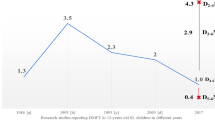Abstract
Objective To assess the prevalence, severity and impact of dental pain.
Design Cross-sectional survey.
Setting Schools in the London Borough of Harrow, England, in the summer term of 1995.
Subjects and methods The base population were all 2,300 8-year-old school children in Harrow. A cluster sampling of schools based on quotas from all postcode areas in Harrow was used. Data were collected through interviews with the children.
Main outcome measures Prevalence of previous toothache; prevalence of toothache in the previous 4 weeks; prevalence of toothache in the previous 4 weeks which resulted in a visit to the dentist, in stopping playing, eating, sleeping, going to school and taking painkillers.
Results Of the 664 sample of children in the participating schools, 589 were interviewed (88.7%). The frequency of previous toothache was 47.5% (95% CI, 44–52) and dental pain caused crying in 17.7% (95% CI, 15–21) of children. 7.6% (95% CI, 5–11) of children had pain in the previous 4 weeks (45 children). Among these 45 children, this recent pain resulted in a visit to the dentist in 41.9% (19 children, ie 3.2% of all children), in stopping playing in 26.7% (12 children, ie 2.0% of all children), eating in 73.3% (33 children, ie 5.6% of all children), sleeping in 31.1% (14 children, ie 2.4% of all children) and in going to school in 11.1% (5 children, ie 0.8% of all children).
Conclusion Toothache in children is a sizeable problem in Harrow and had substantial consequences for children and their guardians. Freedom from disabling dental pain/discomfort is an outcome indicator of oral health and could be used as an explicit goal by dental systems. It is important to note however, that the present study did not assess the extent to which the dental pain was associated with avoidable dental problems as opposed to normal physiological processes. It is important that future work try and separate the prevalence of dental pain caused by physiological from avoidable pathological factors. In addition, future work is needed to assess how effectively and efficiently dental services are responding to people suffering with dental pain.
Similar content being viewed by others
Log in or create a free account to read this content
Gain free access to this article, as well as selected content from this journal and more on nature.com
or
References
Todd J E . Children's dental health in England and Wales 1973. London: HMSO, 1975.
Miller J . Waste of dental pain. Int Dent J 1978; 28: 66–71.
Miller J, Swallow J N . Dental pain and health. Publ Hlth London 1970; 85: 46–50.
Bailit H L . The prevalence of dental pain and anxiety: their relationship to quality of life. NY State Dent J 1987; 53: 27–30.
Woodward G L, Leake J L, Main P A . Oral health and family characteristics of children attending private or public dental clinics. Community Dent Oral Epidemiol 1996; 24: 253–259.
Slade G D, Spencer A J, Davies M J and Burrow D . Intra-oral distribution and impact of caries experience among south australian school children. Aust Dent J 1996; 41: 343–350.
Savedra M, Gibbons P, Tesler M, Ward J and Wegner C . How do children describe pain? A tentative assessment. Pain 1982; 14: 95–104.
Katz E R, Sharp B, Kellerman J et al. Endorphin immunoreactivity and acute behavioral distress in children with leukemia. J Nerv Ment Dis 1982; 170: 72–77.
Rende R D, Plomin R . Child and parent perceptions of the upsettingness of major life events. J Child Psychol Psychiatry 1991; 32: 627–633.
Alwin N P, Murray J J, Britton P G . An assessment of dental anxiety in children. Br Dent J 1991; 171: 201–207.
Pitts N B, Palmer J D . The dental caries experience of 5-year-old children in Great Britain. Surveys coordinated by the British Association for the Study of Community Dentistry in 1993/94. Community Dent Health 1995; 12: 52–58.
Author information
Authors and Affiliations
Additional information
Refereed Paper
Appendix — Questionnaire
Appendix — Questionnaire

Rights and permissions
About this article
Cite this article
Shepherd, M., Nadanovsky, P. & Sheiham, A. The prevalence and impact of dental pain in 8-year-old school children in Harrow, England. Br Dent J 187, 38–41 (1999). https://doi.org/10.1038/sj.bdj.4800197
Received:
Accepted:
Published:
Issue date:
DOI: https://doi.org/10.1038/sj.bdj.4800197
This article is cited by
-
Prevalence of toothache and associated factors in children and adolescents: a systematic review and meta-analysis
Clinical Oral Investigations (2022)
-
Global and regional estimates of dental pain among children and adolescents—systematic review and meta-analysis
European Archives of Paediatric Dentistry (2021)
-
Association between severe unaddressed dental needs and developmental health at school entry in Canada: a cross-sectional study
BMC Pediatrics (2019)
-
Brushing RemInder 4 Good oral HealTh (BRIGHT) trial: does an SMS behaviour change programme with a classroom-based session improve the oral health of young people living in deprived areas? A study protocol of a randomised controlled trial
Trials (2019)
-
Paediatric dento-facial infections – a potential tool for identifying children at risk of neglect?
British Dental Journal (2018)



